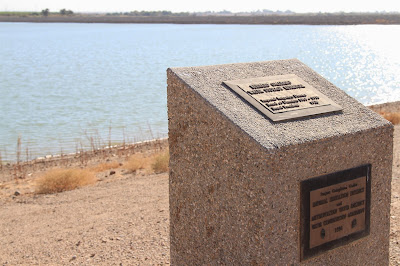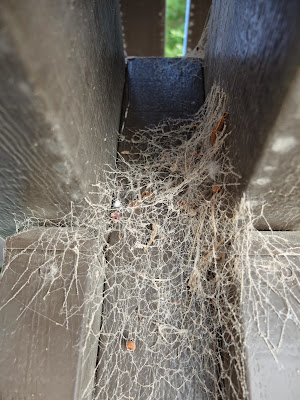Growth in the Imperial Valley: Left: Pumps at the Bernard Galleano Reservoir Move Water Critical to the Economics of the Valley; Center: Solar Panels Sprouting in the Desert – a New Economic Future?; Right: Old Crop and New Hope: Olives in the Valley
Another Thanksgiving in the Imperial Valley and besides our post on the Slab City Tank Farm Murals – Wheel of Kama and Jujube – Imperial Valley, we have a miscellany of other tidbits of information to spew, including information about local destinations, flora, and fauna.
Local Destinations
Nana Dora’s and a Special Quesadilla
Yes, another lunch at Nana Dora’s in Brawley and a special quesadilla. Be prepared for indifferent service when you order, but the food makes up for it. I ordered the folded soft taco with guacamole. I asked what my meat choice was and got a blank stare. “Beef or chicken, but we don’t have chicken.” Okay, I take the beef. The special quesadilla was delicious.
Nana in the name of the restaurant likely means grandmother. In Italian, nana is a female dwarf, which is what I think of when we pull into the parking lot of Nana Dora’s.
Bernard Galleano Reservoir
The Bernard Galleano Reservoir is named after one of the Travelmarx grandfathers. Bernard Galleano was a Calipatria area farmer and member of the IID (Imperial Irrigation District) Board of Directors. The reservoir was dedicated in 1991. The reservoir covers 40 acres and has a depth of 21 feet. The reservoir is open to the public for viewing and fishing. Enter on the west side where there is a “gate” and stairway that takes you up to a viewing area.
The reservoir has been on our list of things to see in the Valley – hey we are working hard to drum up interesting things to do there. The reservoir is located at the terminus of the East Highline Canal just north of Niland, at the crossing of Z Lateral with Wilkins Rd (33°16'34.5"N 115°31'30.3"W).
Left: Viewing Area of Galleano Reservoir; Right: Dedication Plaque (It reads “Bernard Galleano Water Storage Reservoir, Imperial Irrigation District, Board of Directors 1965 – 1978, Board President 1978)
Flora
Olives in the Valley?
Olives are now being grown in the Valley. The article Famers hope to strike gold with olives, says that olives are just getting going, with miniscule olive production to date; alfalfa and wheat are still the main crops. (Though, I seem to see a lot of sugar beets when we drive around.) The olives are being grown for milling into extra virgin olive oil.
We saw two different olive plantings. One planting, north of Niland, had more mature trees around 10+ feet tall. We spotted olives on a few trees. Another, younger planting, northeast of Imperial off 111, had smaller trees averaging 3 feet tall. What was striking about the plantings was how close together the olive trees are. Coming from our experiences in Europe, we had romantic notions of stately old trees spaced far apart. Not so here. In the article Olive plantings expand into Southern California, Arizona, it mentions that the planting style as SHD - super high density.
We may have to wait a few more years before we see the olio di oliva vergine della valle imperiale, but it may not be soon enough as olive production was decimated in Italy yet again this year. See Blight continues to Threaten Olive Crops in Italy and Amid Bugs, Hail, Floods and Bacteria, Italian Olives Take a Beating.
Left: Olive Trees North of Niland; Center: Olives on the Tree; Right: Olive Trees Near Imperial
Tree Shopping
We went shopping for trees that could withstand dry, alkaline locations. We didn’t buy anything, but came away with the following tree candidates:
Dalbergia sissoo
Common names: "Indian Rosewood", "Desert Aspen"
Description: Part of the pea family. Evergreen. It’s currently a popular tree planted in the Imperial Valley.
Cercidium x 'Desert Museum'
Common names: Thornless Palo Verde Tree
Description: See Arid Zone Trees and the Monrovia entry for Desert Museum Palo Verde. For reference, the "normal" Palo Verde is Parkinsonia florida (syn. Cercidium floridum).
Melaleuca quinquenervia
Common names: Paperbark Tree
Description: Myrtle family. Spongy bark. Bottlebrush-like flowers in spring. Evergreen.
Pistacia x 'Red Push'
Common names: Red Push Pistache
Description: A hybrid between P. atlantica and P. integerrima that everyone is praising for its color: the leaves emerge with a red tint, mature to green, and in fall turn shades of red, orange and yellow. See the description at Mountain States Wholesale Nursery and the Red Push Pistache brochure.
Roadside Nightshade
Walking along some solar fields (yes, like olives, another new development in the Valley) we saw these tomato-like plants. After a little poking around on the Internet (doesn’t every trip with a camera end up like that?) we believe they are indeed in the nightshade family (Solanacae) like the common tomato (Solanum lycopersicum). The plants we saw – and are pictured below – are likely Solanum elaeagnifolium, called silver-leaved nightshade.
Fauna
Sandhill Cranes
We saw Sandhill Cranes (Gru canadensis) near Osterkamp Ranches. There is a field (32°53'58.9"N 115°28'50.9"W) with water flowing through it and a viewing area with seating and a barbeque. (A private duck club? What goes on that bbq?) The cranes were landing in and around the field, along with other birds. The most obvious feature of these birds when you see them approaching from a distance is their call which has been described as a loud trumpeting sound. We never got close to them, so you only get a photo of them here in flight.
Left: Cranes in the Sky Over Imperial Valley; Right: The Cranes Page from the iOS Peterson Birds Guide

Burrowing Owls
We saw burrowing owls, Athene cunicularia, subspecies hypugaea according to California Partners in Flight Desert Bird Conservation Plan. The 2012 Burrowing Owl Report from the IID states that 70% of California’s burrowing owl population is estimated to be in the Imperial Valley.
As we walked along the perimeter of solar fields we noticed stacked hale bales, which are placed to protect occupied burrows from project activities. Make’s it easy to know where to look for the owls, though they seem pretty shy and we didn’t get that close to them.
Left: Hay Bales as Protection for the Owls; Right: A Burrowing Owl
Kukulcania arizonica Webs
We’ve written about these spiders in the past (Kukulcania arizonica – Arizona Black Hole Spider (Would the Real Phyllis Paddit Please Come Out?), and we continue to be fascinated by their webs, which really do cover everything. (No night time hunting for spiders this trip.)


















No comments:
Post a Comment
All comments are moderated. If your comment doesn't appear right away, it was likely accepted. Check back in a day if you asked a question.